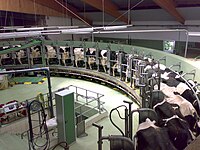
Photo from wikipedia
BACKGROUND In recent years, the mare's milk has been introduced as a rich source of nutrients with hypoallergic characteristics which is widely used for Iranian infants. OBJECTIVES The present study… Click to show full abstract
BACKGROUND In recent years, the mare's milk has been introduced as a rich source of nutrients with hypoallergic characteristics which is widely used for Iranian infants. OBJECTIVES The present study aimed to investigate the heavy metal concentration of mare's milk and its consumption risk assessment. METHODS About 88 mare's milk was collected from Yazd, the centre of Iran, during the summer of 2020. The raw mare's milk was digested and analysed for mineral and heavy metal content (As, Ca, Cd, Co, Cu, Fe, Mg, Mn, Ni, P, Pb and Zn) by ICP-OES. To estimate the health hazard for consumers the Estimated Daily Intake (EDI), Hazard Quotient (HQ) and Hazard Index (HI) of heavy metals were determined. RESULTS The Ca ranged from 260.52 to 201.43 mg/L, which was the highest mineral in mare's milk followed by P and Mg. By increasing the age, P and Ca content was increased. The obtained ranges of Cu, Co, Fe, Mn and Zn were 72.12-75.11, 1.12-9.3, 180.69-230.21, 31.24-47.13 and 1060-1200 μg/L, respectively. The Cd and Arsenic content of mares' 8-11 years of age had higher concentrations. The highest Pb content was reported in mares 4-7 years old (10 μg/L). Although, Pb, Cd and As content of the mare's milk was evaluated lower than the permissible limit. Also, the HQ value was As > Cd > Pb > Zn > Ni > Cu for infants, toddlers and adults. The HI of mare's milk was 0.16, 0.15 and 0.022 for infants, toddlers and adults, respectively. CONCLUSIONS Mare's milk could be an effective nutrition source for infants and children suffering from milk protein allergies.
Journal Title: Veterinary medicine and science
Year Published: 2023
Link to full text (if available)
Share on Social Media: Sign Up to like & get
recommendations!